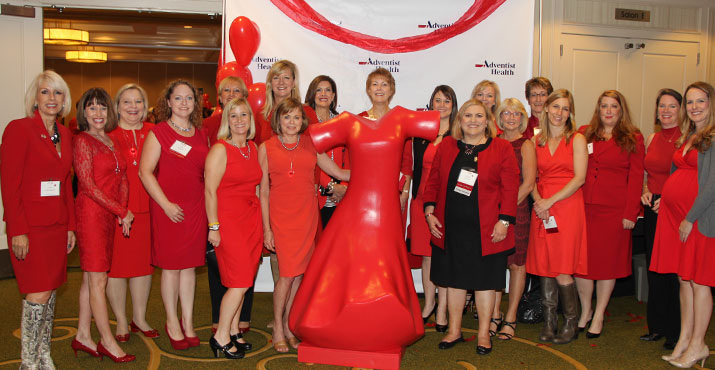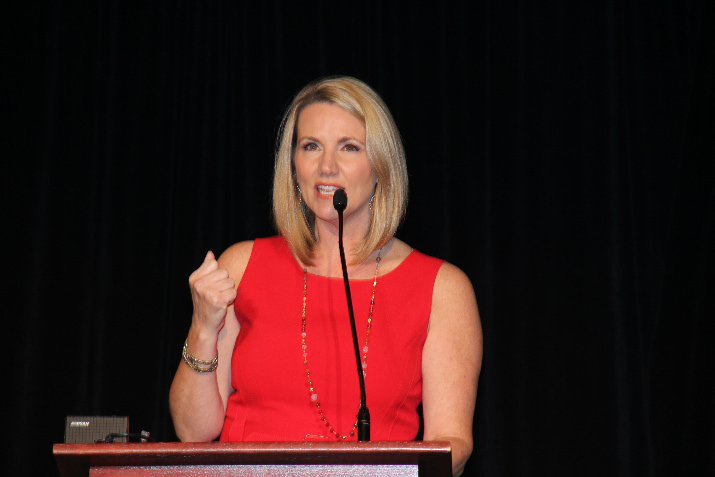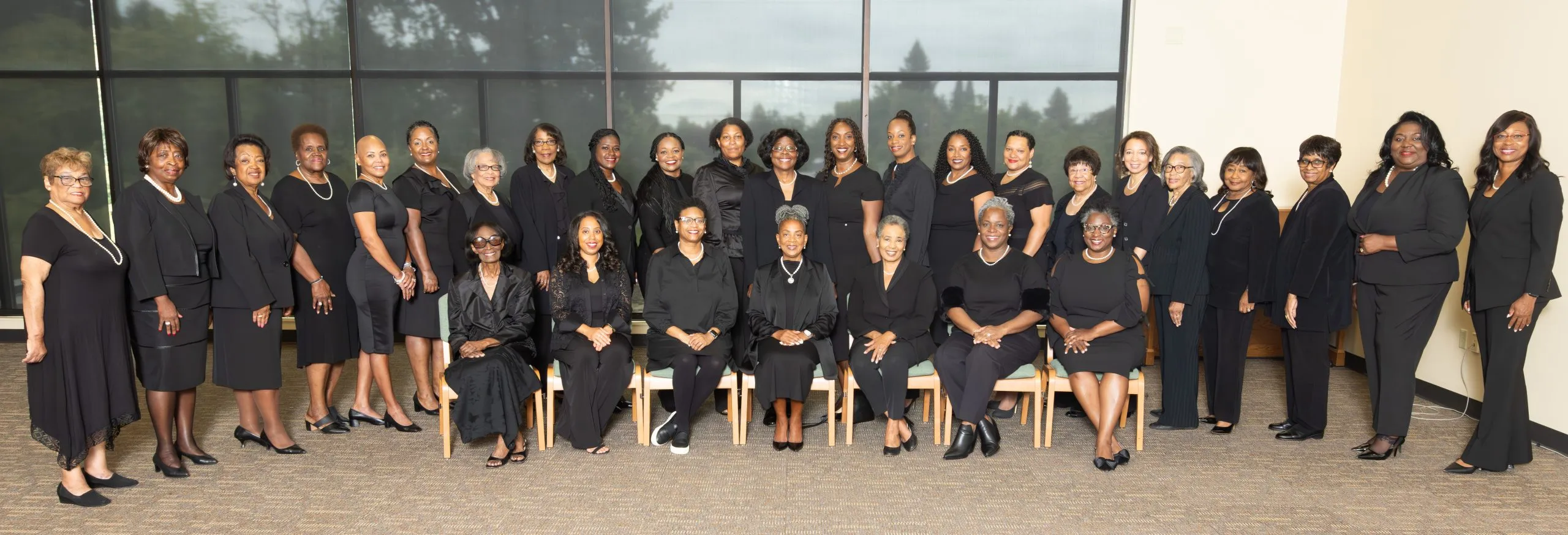

Circle of Red Women (Circle of Red is a society of women who have the passion, the motivation and inspiration to drive and influence change in the community regarding heart health of women in their community)
Portland, October 9th, 2014. The American Heart Association’s Go Red For Women Luncheon raised $211,500 in support of life-saving research, education and outreach in the community. The Circle of Red Women were on hand to celebrate at the Marriott in downtown Portland. Organizers explain, “The Circle of Red is a society of women who have the passion, the motivation and inspiration to drive and influence change in the community regarding heart health of women in their community.” Kiki Hillman chaired the event which drew 480 suporters.
From the American Heart Association:
Who We Are
The American Heart Association is the nation’s oldest, largest voluntary organization devoted to fighting cardiovascular diseases and stroke.Founded by six cardiologists in 1924, our organization now includes more than 22.5 million volunteers and supporters working tirelessly to eliminate these diseases. We fund innovative research, fight for stronger public health policies and provide lifesaving tools and information to save and improve lives.Our nationwide organization includes 144 local offices and nearly 2,700 employees. We moved our national headquarters from New York to Dallas in 1975 to be more centrally located. The American Stroke Association was created as a division in 1997 to bring together the organization’s stroke-related activities.
Our Mission
Building healthier lives, free of cardiovascular diseases and stroke. Our mission drives everything we do.
What We Do
To improve the lives of all Americans, we provide public health education in a variety of ways.
We’re the nation’s leader in CPR education training. We help people understand the importance of healthy lifestyle choices. We provide science-based treatment guidelines to healthcare professionals to help ensure the best treatment for every patient, every time. We educate lawmakers, policy makers and the public as we advocate for changes to protect and improve the health of our communities.
Our volunteer experts select scientific research most worthy of funding – with great results. We have funded more than $3.5 billion in research since 1949, more than any organization outside the federal government. We have funded 13 Nobel Prize winners and lifesaving advancements such as the first artificial heart valve, cholesterol-inhibiting drugs, heart transplant capabilities, and CPR techniques and guidelines.
Why We’re Needed
Heart disease is the No. 1 killer of Americans. Stroke ranks fourth and is a leading cause of severe adult disability.
Each year, these diseases kill more than 811,000 Americans, which is roughly the same as the entire population of El Paso, Texas; Baton Rouge, La.; or Tacoma, Wash.
Some form of cardiovascular disease affects more than one in every three adult Americans. Many suffer terribly from disabilities caused by these diseases.
Our 2020 Goal
We are working toward improving the cardiovascular health of all Americans by 20 percent, and reducing deaths from cardiovascular diseases and stroke by 20 percent, all by the year 2020.
Our programs, educational resources and advocacy initiatives are all targeted at helping people identify and adopt healthier lifestyles.
To assess your cardiovascular health, all you need to do is visit MyLifeCheck.org and answer a few questions. You will learn about modest changes that could make major differences.
For more information, visit heart.org or call 1-800-AHA-USA1.
History of the American Heart Association
Before the American Heart Association existed, people with heart disease were considered to be doomed to complete bed rest – or worse. But a handful of pioneering physicians and social workers believed it didn’t have to be that way. They conducted studies to learn more about heart disease, eventually leading to the founding of the American Heart Association in 1924.
“We were living in a time of almost unbelievable ignorance about heart disease,” said Paul Dudley White, one of six cardiologists who founded the organization.
The early American Heart Association enlisted help from hundreds, then thousands, of physicians and scientists. The association reorganized in 1948, transforming from a scientific society to a voluntary health organization composed of both science and lay volunteers and supported by professional staff. Since then, the American Heart Association has grown rapidly in size and influence – nationally and internationally.
In 1975, the headquarters moved from New York City to Dallas to be more centrally located. Volunteer-led affiliates formed a national network of local organizations providing research funding, education, community programs and fundraising.
In the 1980s, the association became a much more visible champion of public health, starting advocacy efforts that remain active today locally across America in all 50 states and in Washington. Large gifts allowed the association to support new research projects and education programs, including more efforts to address heart disease and stroke in women and minorities.
The 1990s were a time of great change. In 1997, the confederation of separately incorporated affiliates merged into a single corporation. That year the American Heart Association also created the American Stroke Association and another division dedicated to CPR training and other emergency cardiac care.
Our scientific findings began to move from laboratories and clinics to physician’s offices and American households. The association took positions on important health issues. And despite strong opposition from the tobacco industry, the American Heart Association continued to advocate for the public, especially children.
By 2000, the American Heart Association had established its first 10-year Impact Goal for the entire nation: to reduce coronary heart disease, stroke and risk factors by 25 percent by 2010.
The goals for reducing deaths were exceeded. However, with national trends such as increasing obesity and sedentary lifestyles, we still had much more work to reduce risks. And that drove the association to set another aggressive 10-year Impact Goal for the nation: To improve the cardiovascular health of the entire nation by 20 percent by 2020, while reducing deaths from cardiovascular diseases and stroke by 20 percent.
Today, the American Heart Association works toward that goal as the nation’s oldest and largest voluntary health organization devoted to fighting heart disease and stroke. We have more than 22.5 million volunteers and supporters supported by nearly 150 local offices.
The association is a leader in public health education and science. We train more than 13 million people a year in CPR. We publish popular cookbooks and certify heart-healthy foods in grocery stores. Our programs improve the health of America, fight childhood obesity and reach audiences facing unique health risks, including women, African-Americans and Hispanics.
The association continues to be true to its scientific roots, funding more cardiovascular research than any U.S. organization aside from the government. We have funded 13 Nobel Prize winners and numerous scientific breakthroughs. Our conferences train thousands of healthcare professionals, and we set scientific treatment guidelines followed by hospitals nationwide.
The American Heart Association wants everyone to understand the threat – and to know that cardiovascular diseases are largely preventable. Risks can be lowered by adhering to what we call Life’s Simple 7: not smoking, being physically active, maintaining a healthy body weight, eating a healthy diet, controlling blood pressure, controlling cholesterol and controlling blood sugar.
Recent Posts
Portland Art Museum Exhibit Will Highlight Contemporary Art from the Collections of Jordan D. Schnitzer
Portland, OR. Opening in September 2025, the Portland Art Museum (PAM) presents Global Icons, Local Spotlight:…
VIPs Gearing up for Classic Wines Foundation Gala
Portland, OR. Organizers say the "Salon de Vin" benefit for Classic Wines is shaping up.…
Diamonds & Denim Gala Will Benefit The Links, Inc.
Portand, OR. The Portland Chapter of The Links, Incorporated, and the White Rose Educational Foundation…
Nonprofits Honored as Providence Health Plan Celebrates 40th Anniversary
Portland, OR. Providence Health Plan recently celebrated its 40th anniversary with a totally rad 1980’s…
Oregon Historical Society Hosts History Makers Gala
Portland, OR. The Oregon Historical Society’s (OHS) annual Oregon History Makers Awards & Dinner recognizes…
Lan Su Garden Kicks off November With Floral Design Competition
Portland, OR. Move over pumpkins, the Lan Su Chinese Garden is welcoming fall with its…



